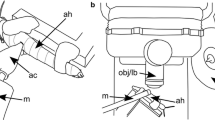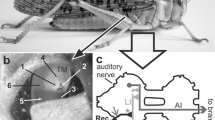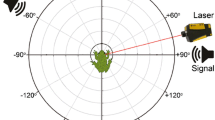Summary
The sensitivity of three different preparations of the tympanal organ (“isolated”, “operated”, and “intact”, see Fig. 7a–c) has been measured over a wide range of frequencies (Figs. 3 and 6). The sensitivity of the intact ear to low frequency sound depends on the fat content of the animal (Figs. 4 and 5). The effect of diffraction (Fig. 8), the sound absorption in internal tissues (Fig. 10), and the sound transmission through the animal (Fig. 9) have been measured in order to explain the observed sensitivities in the three preparations. The internal tissues seem to act as an acoustic low-pass filter. Therefore, at high frequencies the intact and operated ears are acting almost as pressure receivers (Fig. 2a). The isolated ear is acting as an unbaffled pressure gradient receiver (Fig. 2b) with an “effective distance” of 0.8 mm. A mathematical model for asymmetric sound receivers is presented and used to calculate the force acting to move the tympanum in the operated ear at low frequencies. The driving forces in intact and operated ears are of the same order of magnitude as in a similar pressure receiver (table). The membrane vibrations at high frequencies are heavily damped both by the radiation resistance and by friction in the internal tissues behind the ear. The implications of these results for the understanding of directivity are discussed. Some common methods for determination of threshold are compared.
Similar content being viewed by others
References
Autrum, H.: Über Lautäußerungen und Schallwahrnehmung bei Arthropoden. II. Das Richtungshören vonLocusta und Versuch einer Hörtheorie für Tympanalorgane vom Locustidentyp. Z. vergl. Physiol.28, 326–352 (1941).
—, Schwartzkopff, J., Swoboda, H.: Der Einfluß der Schallrichtung auf die Tympanal-Potentiale vonLocusta migratoria L. Biol. Zbl.80, 385–402 (1961).
Beranek, Leo L.: Acoustics. New York: Mc-Graw-Hill 1954.
Lawson, J. L., Uhlenbeck, G. E.: Threshold signals. New York: McGraw-Hill 1950.
Lax, M.: The effect of radiation on the vibrations of a circular diaphragm. J. acoust. Soc. Amer.16, 5–13 (1944).
Michelsen, A.: The physiology of the locust ear. I. Frequency sensitivity of single cells in the isolated ear. Z. vergl. Physiol.71, 49–62 (1971).
—: The physiology of the locust ear. II. Frequency discrimination based upon resonances in the tympanum. Z. vergl. Physiol.71, 63–101 (1971).
Morse, Ph. M.: Vibration and sound. New York: McGraw-Hill 1948.
Pumphrey, R. J.: Hearing in insects. Biol. Rev.15, 107–132 (1940).
Roeder, K. D.: Acoustic sensitivity of the noctuid tympanic organ and its range for the cries of bats. J. Insect. Physiol.12, 843–859 (1966).
Skudrzyk, E.: Die Grundlagen der Akustik. Wien: Springer 1954.
Author information
Authors and Affiliations
Rights and permissions
About this article
Cite this article
Michelsen, A. The physiology of the locust ear. Z. Vergl. Physiol. 71, 102–128 (1971). https://doi.org/10.1007/BF01245156
Received:
Published:
Issue Date:
DOI: https://doi.org/10.1007/BF01245156




